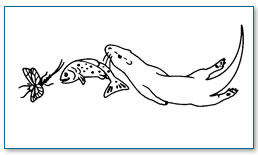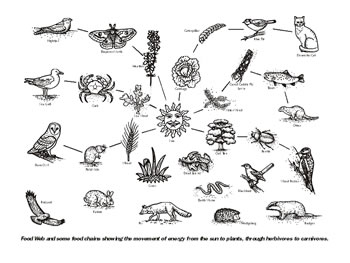food
webs and chains
 |
Water vole |
In the sections on River
Wildlife (B09) and Biodiversity
(B06), we looked at the variety of plants and living
creatures that live in or near rivers and wetlands. These living
creatures can be birds (B09b),
mammals (B09c),
fish (B09d),
amphibians (G1),
reptiles, insects and other mini-beasts (B09a).
All these creatures need energy to live and are dependent on one
another for food to give them energy. When an animal eats food,
energy passes from the food into the animal.
Plants get their energy from
the sun through a process called photosynthesis (G1).
Photosynthesis is how plants make food by using solar energy to
convert water and carbon dioxide into sugar.
 |
Food chain |
A food chain shows how energy
moves from the sun into plants and animals. Different species eat
different foods and are represented by a different food chain. These
different food chains can be built up into a food web.
Example
1: a short food chain:
A Reed Mace growing at the edge of a pond gets energy to grow from
the sun - its leaves are eaten by a Pond Snail - a Duck eats the
Pond Snail.
 |
The sun |
• Draw this food chain by starting with a drawing of the sun
and the plant and the animals. Then link these elements with arrows.
The arrows show the movement of energy from the sun through the
links in the food chain.
 |
Water shrew |
Example
2: a longer food chain:
A waterlily receives energy from the sun, the plant dies back in
the winter and the dead leaves from the plant drop down to the bottom
of the pond and are eaten by a water louse. The water louse is eaten
by a Dragonfly Nymph, which in turn is eaten by a Water Shrew. The
Water Shrew is caught and eaten by a Kestrel.

click on the image to open an
enlarged printer friendly version of the food web diagram
Wetland Diet Sheet
This list provides information
on how some of the river and wetland residents get their energy.
All types of animals get their energy from the food they eat and
plants get their energy from sunlight.
SPECIES |
ENERGY
SOURCE (sunlight or food) |
| Adult Damselfly |
Other adult insects |
| Adult Dragonfly |
Other adult insects |
| Adult Frog |
Insects, water worms, snails, slugs, worms |
| Adult Mayfly |
Does not eat since it only lives for a day
or two, it uses the energy gained when it was a nymph |
| Adult Newt |
Water fleas, water worms, caddislfy &
mayfly numphs, freshwater shrimp, midge larvae, pond snails |
| Algae |
Sunlight |
| Arrowhead |
Sunlight |
| Caddislfy Larva |
Microscopic plants, algae, microscopic fungi,
small particles of dead plants |
| Cyclops |
Microscopic animals and microscopic plants |
| Damselfly Nymph |
Tadpoles, young fish, cyclops, waterfleas,
freshwater shrimps, water lice and beetles |
| Dead Plant Particles |
Sunlight |
| Dragonfly Nymph |
Tadpoles, young fish, cyclops, waterfleas,
freshwater shrimps, water lice and beetles |
| Duck |
Pondweed, large water plants, insects, tadpoles,
small fish, pond snails |
| Flatworm |
Water lice, waterfleas, cyclops, watermite,
microscopic animals, tadpoles and caddisfly larva |
| Freshwater Shrimp |
Microscopic fungus, small particles of dead
plants |
| Frog Tadpole |
Microscopic plants, algae, water worms,
midge larvae, cyclops |
| Great Diving Beetle |
Cyclops, Water fleas, midge larvae, pond
snails, nymphs, tadpoles, flat worms, leeches, water boatmen |
| Eel |
Stickleback, freshwater shrimps, frogs,
dead fish, river snails |
| Heron |
Fish, adult frogs and tadpoles, small birds,
larger insects |
| Kestrel |
Water shrews |
| Kingfisher |
Small fish, tadpoles, small frogs, great
diving beetle |
| Leech |
Insect nymphs, tadpoles, flat worms, water
lice, pond snails, midge larvae |
| Marsh Marigold |
Sunlight |
| Mayfly Nymph |
Microscopic fungi, microscopic animals and
plants, small particles of dead plants |
| Microscopic Animals |
Microscopic plants, small particles of dead
plants |
| Microscopic Fungus |
Dead plants |
| Microscopic Plants |
Sunlight |
| Midge Larva |
Microscopic plants, small particles of dead
plants |
| Newt Tadpole |
Microscopic plants, algae, midge larvae,
cyclops, fresh water shrimps, water worms |
| Pond Skater |
Remains of dead plants and dead animals |
| Pond Snail |
Large water plants and algae |
| Reed Mace |
Sunlight |
| Trout fry |
Tadpoles, young fish, cyclops, water fleas,
freshwater shrimps, water lice and beetles |
| Salmon fry |
Tadpoles, young fish, cyclops, water fleas,
freshwater shrimps, water lice and beetles |
| Sticklebacks |
Tadpoles, young fish, cyclops, water fleas,
freshwater shrimps, water lice and beetles |
| Water Boatmen |
Tadpoles, freshwater shrimps, water worms,
midge larvae, water fleas, cyclops |
| Water Flea |
Microscopic plants, small particles of dead
plants |
| Water Louse |
Microscopic plants, fungi, small particles
of dead plants |
| Water Mite |
Body fluids of beetles, water boatmen, pond
skaters and insect nymphs |
| Water Shrew |
Pond Insects, water worms, tadpoles, small
frogs |
| Water Worm |
Microscopic fungi, small particles of dead
plants |
Exercises:
1) Complete
the arrows on the food web showing the direction in which energy
moves.
2) Using the
information in the Wetland Diet Sheet, draw your own food chain
- remember that energy always starts with the sun.
|

